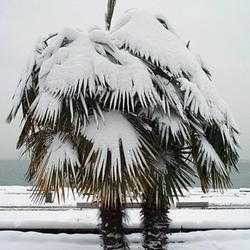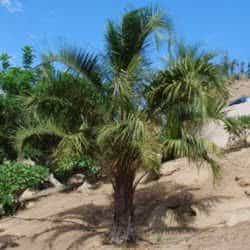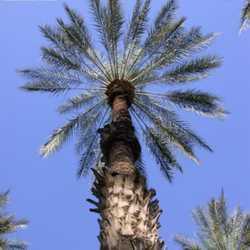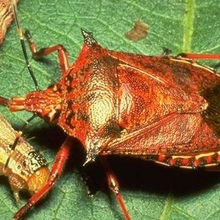(Editor's Note: This article was originally published on March 15, 2008. Your comments are welcome, but please be aware that authors of previously published articles may not be able to promptly respond to new questions or comments.)
Phoenix palms are pinnate, single to multitrunked dioecious (trees are either male or female, not both) palms from the continents of Africa and Asia. This genus includes some of the fastest growing palms in the world, as well as the tallest. However, one of the smallest palms in the world is also in this group. The true Date Palm, Phoenix dactylifera, is the most economically important palm next to the coconut palm and is a source of food and thatch for dozens of equatorial countries in the old world. The pygmy Date Palm and the Canary Island Date Palm are two of the most commonly planted landscape palms in the world. The following is an overview of this interesting palm group along with some cultivational information and photos.
Phoenix acaulis- I have seen a number of palms identified as this in botanical gardens in both Florida and California, but I have strong doubts about the correct identity of any of these specimens. This dwarf, trunkless Indian palm is one of the least ornamental of the genus having only a half dozen or so wispy, soft leaves at a time. In the wild it is nearly indistinguishable from a clump of grass or weeds. Presumably the presence of mislabeled palms is due to the Phoenix genus being so easily hybridized that seed, even from a true individual can produce hybrid offspring very unlike the female parent. Most palms identified as this species in botanical gardens are short but trunking species, easily 10-100x the size of the true species, and obviously hybrids.
 Phoenix acaulis growing in Florida... maybe
Phoenix acaulis growing in Florida... maybe
Phoenix canariensis- from the smallest to the biggest.... This is one of the largest, most massive palms in cultivation. As the name suggests, it is a native of the Canary Islands. Though it doesn't produce any edible dates (they are literally edible, but no one would want to eat them) it is still a commercially important tree, being one of the most popular and costly landscape palms for use as a city street tree, mall tree, or for zoos, botanical gardens etc. One large tree can cost thousands. Thankfully they are relatively ‘easy' to move (high survivability) as long as the trunk is not damaged or it doesn't get too desiccated in the process of moving, or become infected with something.

rare variegated plant from the Canary Islands (photo by semillas)
This is a solitary, fast-growing, thick-stemmed (2' or more in diameter) palm growing up to a height of 80' or more. Palms in Los Angeles planted over 100 years ago seem to top out about this height and then slowly die. The leaves of this palm are long and arching with the stiff, pointed leaflets coming off the rachis in two slightly different planes, though the overall effect is that of a nearly flat leaf. The leaf color is a light to deep green. The crown of this species consists of up to 100 leaves over 30' in diameter, so very little sun gets through. Maturing palms create a lot of deep shade thanks to their massive dense crowns. Modified leaves in the form of very sharp stiff spines occur near the leaf bases, making this palm a very dangerous one to prune. These spines grow up to 15" long and can easily penetrate all but the thickest leather gloves and are certainly an ocular hazard. If left to fall naturally the leaf bases leave a rough diamond pattern along the trunk. However, most growers prune the leaf bases to a smooth, almost polished finished making the trunks a living work of art. The tops of the trunks are often pruned carefully leaving much more leaf base giving a bulbous ‘pineapple' look to the pruned crown. Over-pruning is a common practice with this palm and isn't recommended, but is also understandable considering the cost and hazard of pruning.


Overpruned palm on the left and a close up of the trunk with the current 'style' of pruning the upper leaves
This is a very hardy species able to survive temps just below the 20s. It also performs well in hot arid climates (though not as well as some other Phoenix species) and is also grown commonly in humid, hot climates, though it definitely seems less happy in these more tropical surroundings. Once established it is a very drought and wind tolerant plant. Soil preferences are few, and it grows extremely well in heavy clay soils most other palms detest. Nutrient deficiencies, at least in California soils, are few and fertilization is often unnecessary.



This photo shows the dense leaf crown Old palm in foreground LA with Phoenix dactylifera in back ground for comparison in middle photo... photo on right shows a perfect specimen in a park
Some Phoenix are fairly resistant to Lethal Yellowing (a serious viral disease of many palms species), but this one is not. Forutunately that is a rare disease in Mediterranean climates. However, these trees are also exceptionally prone to a fungal infection called Fusarium wilt. This is a disease carried from one infected palm to another palm via uncleaned or poorly cleaned pruning equipment. Many palms in southern California die every year from this infection spread by careless gardeners and landscapers. Sadly, once infected, death is nearly always inevitable. And once a Phoenix dies of this, the soil surrounding its roots becomes infected with the fungus for many years to come. So any palm that is removed cannot have another Phoenix in it's place or the same end result will occur (other species, such as Washingtonias or Braheas can be put in instead, though, as they are resistant to this fungus).
 palms pruned frequently in LA sometimes get fusarium wilt transferred from palm to palm
palms pruned frequently in LA sometimes get fusarium wilt transferred from palm to palm
Phoenix dactylifera- the true date palm. Originating from somewhere in northern Africa presumably, this is the date palm that makes the edible dates the entire genus is known for. Its actual origins are unclear as this plant has been in cultivation for nearly 5000 years, so what are native populations or introduced ones are impossible to tell. It is thought to be a form of Phoenix theophrastii (native to Crete and northern Africa) harvested and selected for its exceptional fruits thousands of years ago. Now it is grown in hundreds of countries throughout the world as a food and landscape plant. There are dozens of date varieties, though that is another article someday.


2 shots of some groves of cultivated Date palms in the deserts of California
This is another tall, fast-growing palm maxing out around 80' as well. Unlike the Canary Island Date Palm, this is a suckering species, though some varieties are more prone to sucker than others. Most cultivated palms are kept pruned back to one trunk not only for landscape purposes but ease of harvesting fruits. Occasionally these palms will actually form a ‘true' branch or two, though most growers remove these- not too ornamental, and eventually get so large they can rip off the main trunk. Phoenix dactylifera has a slimmer trunk than Phoenix canariensis and leaf base scars leave a more three-dimensional, but equally, if not more ornamental naked trunk. The leaves of this species are a glaucous grey-green to dull blue-green, arching and also heavily armed with spines near the base. Leaflets are arranged in two prominent planes giving the effect of being somewhat plumose. The tips of all the leaflets, not just the modified ones, are quite sharp and are potential ocular hazards. The crown of this species is much sparser in appearance than in Phoenix canariensis and the shade created below is more filtered than total.


Phoenix dactyiferas in a zooological park, and close up of the trunk
Phoenix dactylifera is also a hardy species tolerating temps down to about 20F. However for purposes of growing viable fruit this palm has to be grown in a warm, arid climate (like the climate of northern Africa or inland southern California or Arizona). It will grow in a humid, tropical climate but not form very good fruit, and cold climates also retard fruit formation. This palm tolerates a lot of moving abuse with palms over 50' having an excellent track record as transplanted specimens. They are very drought tolerant and the leaves are exceptionally resistant to desiccation which may have something to do with ease of transplanting. Suckers can be carefully removed and rooted (as long as some root tissue taken with them)- this is how all special fruiting varieties are propagated. Few other suckering palms are so easily propagated this way.



Standard landscaping variety of Phoenix dactylifera on left, middle photo is of park tree allowed to sucker, and right is the extreme example of a suckering date palm, Phoenix dactylifera var Zahidi
Phoenix loureirii is the most difficult species both pronounce as well as spell, which may is why it has several synonyms (hanceana, humilis). It is not a common palm in cultivation, at least compared to most other Phoenix species, but it can be a fantastic landscape palm. This species is one of the most variable in form as well as diverse in origin (India, China, Philippines etc.). It can be found in the lower Himalayan forests where it may snow occasionally, to the jungles of the Philippine islands. Some forms are suckering and some solitary, some tall, some short and stocky. Combine this variety with the likelihood of hybridization in cultivation and this palm becomes a very difficult one to describe accurately.
 form sometimes referred to as Phoenix hanceana
form sometimes referred to as Phoenix hanceana
Some divide it up into two forms: Phoenix loureirii var loureirii, and Phoenix loureirii var humilis. The former is the more commonly encountered variety in botanical gardens and it looks a bit like a miniature Phoenix canariensis (sometimes suckering, but usually 1-3 stems only). The stem of this form is often irregularly marked with very closely spaced leaf scars, belying is relatively slow growth rate. The leaves are dark green, stiff, forming a dense, impenetrable crown of spiny leaflets, coming off the rachis in two distinct planes. Some forms of this have blue-green leaves with very sharp, stiff leaflets, and some carefully have selected these for cultivation. Sometimes these forms are referred to as Phoenix 'hanceana'.


solitary and suckering examples of Phoenix loureirii var loureirii
The other form (var humilis) is invariably a suckering tree with thinner trunks and neater, sparser crowns. The leaves on this species have leaflets that appear to be in a single plane, or nearly so, in contrast to the markedly distinct planes seen in the other variety. This variety is much less common in cultivation. That the two are even related is hard to believe sometimes as they about as unalike as any Phoenix species. However, the basis for the varietal designation is strictly based on minute floral morphological differences only. I will never understand taxonomists!
 example of the humilis variety of Phoenix loureirii
example of the humilis variety of Phoenix loureirii
Both forms seem to have fairly good cold tolerance down to the low 20s and tolerate drought, wind, tropical humidity and arid heat equally well.
 trunk detail of Phoenix loureirii
trunk detail of Phoenix loureirii
Phoenix paludosa- the Mangrove Date Palm. This is a Phoenix from the truly tropical environments of Sumatra and Malaysia and one of the least commonly grown Phoenix in cultivation. This small, suckering plant slowly grows in swampy jungles up to 15' tall and small clumps 5'-10' in diameter. The stems are relatively thin for a Phoenix (3"-4") and are usually bent or twisted. Leaves are pale green to grey-green and lighter still on the undersides. The leaves are somewhat soft and droopy, though still armed near the leaf bases. Leaflets are only somewhat stiff and not too dangerous. Cold tolerance of this plant has probably not been fully tested, but so far little or no damage has been seen at temps down into the high 20s.


Phoenix paludosas in the tropics, and in southern California
Phoenix pusilla- the Ceylon Date Palm. This Indian palm (also from Sri Lanka) is another uncommonly grown palm in cultivation mostly due to is less than ornamental appeal and pugnacious nature. It is a shrubby solitary to sometimes suckering species with sharp leaflets that come off the leaves in two distinct planes, making a low-growing impenetrable bush. Older, solitary specimens do eventually form a somewhat ornamental wicker pattern on the trunk from the retained leaf-bases. It is a very slow species and such individuals are fairly old. It's cold hardiness seems to be about on par with Phoenix paludosa- around the mid to higher 20s.



Phoenix pusillas in California and Florida. Plant on right very old and possibly hybrid example, but showing typical wicker pattern of retained leaf bases on trunk
Phoenix reclinata- the Senegal Date Palm. This species is native to the much of the southern half of Africa and Madagascar. It is a large, suckering species growing up to 40'-50' tall on relatively skinny trunks about 8"-1' in diameter. The trunks are covered with black fiber and retained leaf bases (except in very old plants, which can have some bare trunk). Leaflets are generally in 2 planes only offset by a subtle angle, but this trait is quite variable in cultivation, presumably due to the lack of purity of the species (finding a non-hybrid Phoenix reclinata is a difficult task). The leaves are flat-looking from far away- plumose-looking Senegal Date Palms are usually hybrids. Leaves are about 10'-15' long and the leaflets are slightly spiny and bright green. The leave bases are armed with stout, very sharp yellow-orange spines.

 two examples of Phoenix reclinata in cultivation
two examples of Phoenix reclinata in cultivation
This is a moderately cold hardy palm, though reportedly true Phoenix reclinatas are only mildly frost hardy. Most palms cultivated as this in the US are quite hardy- down to nearly 20F, but these are invariably hybrids. This palm is otherwise very adaptable to dry, humid, hot, or cool (frost-free) climates and a wide variety of soil types and pHs. This ‘species' is a very popular landscape palm in front of hotels, malls, parks and even large indoor areas with skylights. Like most Phoenix it is fairly easy to move with little risk of killing the palm, as long as the root-ball doesn't dry out. This palm is only slightly sensitive to lethal yellowing.
 true palm in central Africa (photo by Kylecwaza)
true palm in central Africa (photo by Kylecwaza)
Phoenix roebellenii- Pigmy Date Palm. This is probably the most commonly used landscape Phoenix by homeowners, though it is also used extensively in commercial landscaping. This Asian palm originates from Laos, Vietnam and South China- very tropical climates for such a versatile hardy species. The wild form of this plant is a suckering, thinly crowned plant, sometimes referred to as Phoenix roebellenii Reasoneri in cultivation. However, the most commonly encountered forms of this species in cultivation is as a solitary, more thick-stemmed plant with a thick, luxurious crown of soft, bright-light green leaves. It is interesting that though most cultivated plants are solitary, they are often planted in clusters of individuals giving one the impression that they are indeed clustering palms... however, the clusters of individual palms are still less intensely clustered than the true forms get- the native forms sucker very profusely and eventually form massive thickets of shrubbery, full of twisted, gnarled stems. It is a less than ornamental palm in its original form. The cultivated Phoenix roebellenii grows to about 10' or more in height and has a fiber-coated to naked trunk about 6" in diameter. Leaflets are distinctly soft and droopy though the leaf bases still retain some viciously spiny modified leaves, so care needs to be taken when pruning.


Typical palm in tropical climate 'W ild type' suckering plant in California
This is a mildy cold hardy species being damaged from cold in the upper 20sF, but usually surviving temps down below 25F (just defoliating). This is a water-loving species and it is very difficult to overwater this one. Fortunately it is not picky about soil, so if grown in clay, watering needs are lessened somewhat. It does well in most climates, but prefers some protection from hot, arid summer afternoon sun to look its best. Some grow this as an indoor palm though its lighting needs are intense.



Phoenix roebellenii for sale at garden outlet center Used in public landscaping relatively common sight- multiheaded palm
Phoenix rupicola- Cliff Date Palm. This is an Indian species and some consider this the most ornamental of all the Phoenix. It is a solitary species up to 25' tall or more, with long, arching, soft, deep-green leaves, with all the leaflets in a single plane. This is one of the few Phoenix with no vicious leaf-base spines- there are still some soft spine-like modified leaves, but they are soft and flexible, without a sharp tip. It is hardy to only the upper 20s, though it can survive temps down to 25F with only moderate leaf damage (usually survives such a freeze as long it's brief). It is a moderately slow growing species but still a decent landscape palm. For some reason this palm often shows some degree of nutritional deficiency in California having very yellow leaves typical of a magnesium deficiency in situations where no other Phoenix show any problems at all. This situation is lessened if it is grown in partial shade. This species seems to prefer particularly rich soils.


healthy green plant in partial shade, and severely nutrient deficient plant in full sun, southern California

 two more healthy ones in southern California parks
two more healthy ones in southern California parks
Phoenix sylvestris- Silver or wild date palm- This is an Indian and Pakastani species and is a large, solitary trunked, tall tree (up to 50') with a dense crown of stiff, grey-green leaves (about 100 or more). This species looks a lot like a slightly ‘stiff-leaved' Phoenix canariensis. In fact, it is often confused for one, or vice versa. Again, hybridization muddies the picture a bit and many palms in cultivation may indeed be part Phoenix canariensis, or Phoenix loureirii or dactylifera. It is slightly less hardy to cold than Phoenix canariensis and about as unhappy in warm, humid climates as well. It is a great desert landscape palm and quite drought tolerant. It is quite slow growing however, so tall mature palms are many decades old.
 Phoenix sylvestris (the realy thing) in southern California
Phoenix sylvestris (the realy thing) in southern California
Phoenix theophrastii- some consider this the ‘wild type' of Phoenix dactylifera as the two are very similar. This species seems to sucker much more profusely, however, and the leaflets of this species are incredibly spiny, making it the most painful/dangerous of all the Phoenix species to prune. Leaf color is grey-green but the petioles are an attractive yellow with dark brown making it a moderately ornamental species as long as one keeps the suckers pruned back. It is native to the Mediterranean coasts and Crete. Cold hardiness is about the same as Phoenix dactylifera, as is just about all other aspects of its cultivation. However it does not make good-tasting fruits (edible, yes, but pithy).


Phoenix theophrasitii in cultivation close up of leaf bases showing typical spines of nearly all Phoenix sp.
There are several other species of Phoenix: andamanensis and caespitosa, but these are very rare in cultivation and I have yet to see one of either. The former is from on island off southern India and the latter from Somalia.



hybrid palms: Phoenix roebellenii x paludosa; Phoenix reclinata x dactylifera; Phoenix reclinata x roebellenii



Phoenix canariensis x reclinata Phoenix canariensis x roebellenii Phoenix canariensis x rupicola

Last and least are the metallic Phoenix one can catch a glimpse of all over the southern California landcape, known as Phoenix sp. 'Cell Tower'

















